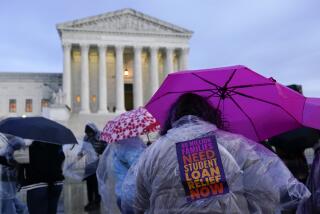Don’t pay a fee to enroll in a biweekly mortgage payment plan
- Share via
Biweekly mortgage payment plans are back.
“Don’t miss out!” proclaims a pitch from Citibank’s BiWeekly Advantage program. “The BiWeekly Advantage Plan is a convenient mortgage budgeting plan that can help you save thousands of dollars in interest and pay off your mortgage sooner.”
Although many people receiving the recent pitches have never heard of biweekly mortgages, they have been around for decades. They simply got mothballed when consumers were more interested in adding to their debt with home equity lines than they were in paying off their loans faster.
What they do is simple: They divide your monthly mortgage payment in half and then automatically debit your account for those half-payments every other week. Because there are 52 weeks in a year — thus 26 half-payments — you’ve made 13 full payments by the end of the year.
Making that one extra payment annually, which feels relatively pain-free when done through this gradual process, causes you to pay off your loan considerably faster and saves you thousands of dollars in interest.
A consumer with a $200,000, 30-year mortgage at 5%, for example, could pay off this loan five years faster and save some $33,000 in interest by paying biweekly, said Diana Rodriguez, a spokeswoman for Wells Fargo Bank.
“That’s a nice long-term savings,” she said. “And it allows you to build equity faster, manage your budget more effectively — and you never have to worry about forgetting to mail your mortgage payment on time.”
But there can be drawbacks.
Although Wells Fargo allows customers to sign up free for biweekly mortgage payments, most lenders charge for the programs. And that’s where it’s tougher to decide whether they’re worthwhile.
Citibank, for example, levies a $375 upfront charge and nicks customers $1.50 for each “transaction” — that’s 26 transactions a year — for an additional annual cost of $39. So assuming that you stick with this program for 25 years, it would cost you a total of $1,350.
That might seem like a relatively small price to pay for a $33,000 savings, but there’s really no reason to pay for these programs, said Ken McEldowney, executive director at Consumer Action in San Francisco. You can set this up yourself at no cost — and by doing it on your own, you give yourself more options and flexibility.
Your options?
•You could pay every other week by setting up regular recurring drafts from your checking account. Mortgage lenders typically don’t charge more to receive two payments instead of one. They will credit your account just once monthly, but that’s what you get with a biweekly plan too. Make sure, however, that your bank will go along with this — some might deduct the mid-month payment from principal, and then still expect the full payment on the first.
•You could make one extra payment at year’s end — or in any month when you happen to have the cash. This will give you a benefit nearly identical to the biweekly mortgage plan but allow you to schedule the payments when you’re flush.
•You could divide your mortgage payment by 12 and pay that much extra each month. If you had that $200,000 loan at 5%, for example, your normal monthly payment would amount to $1,073.64. Divide that by 12 and you get about $89.50. Add that to your normal payment and you’d be sending in roughly $1,163 a month.
•You could simply round up your payment to the next $100 or whatever you can afford. For example, if you opted to pay $1,200 a month instead of $1,073, you’d pay off the 30-year loan in just 24 years and save a tidy $44,524 in interest.
The benefit of these informal plans, besides saving you from paying fees, is that they’re flexible, McEldowney said. If you don’t have the money one month because you spent too much on the holidays, for example, you simply don’t make the bigger payment that month.
Advocates of the fee-based plans say this is exactly why you should enroll, even if it costs you money. They maintain that consumers don’t have the discipline to make bigger payments, so they miss out on the savings.
McEldowney counters that paying your mortgage loan faster saves you interest at a 5% rate, at least in the example above. If doing that means you need to leave a balance on a credit card with a 21% rate, it makes no sense at all.
It’s great to pay off debts faster regardless of whether they’re auto loans, home loans or credit card loans, McEldowney adds. But pay off the high-cost debt first. If you have no other debts, certainly pay extra against the mortgage, but don’t pay a fee to enroll, he advises.
“It’s a good idea if you have the money,” McEldowney said. “But there is absolutely no reason to pay a fee to do this.”
More to Read
Inside the business of entertainment
The Wide Shot brings you news, analysis and insights on everything from streaming wars to production — and what it all means for the future.
You may occasionally receive promotional content from the Los Angeles Times.










